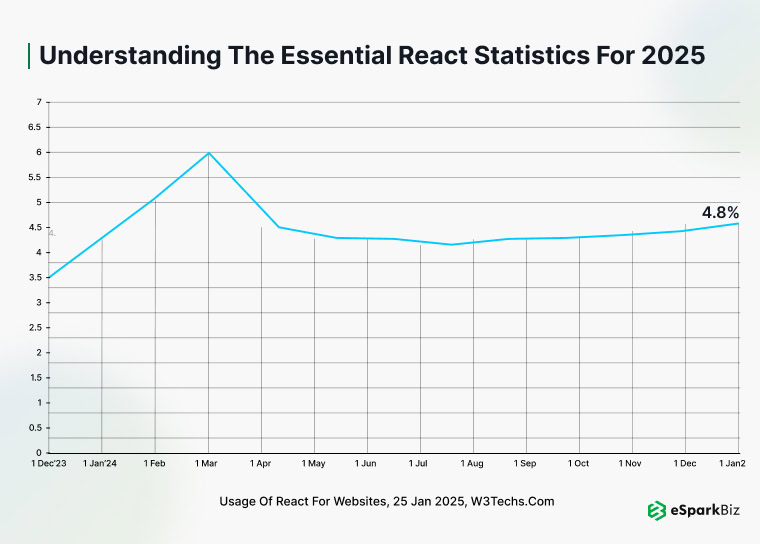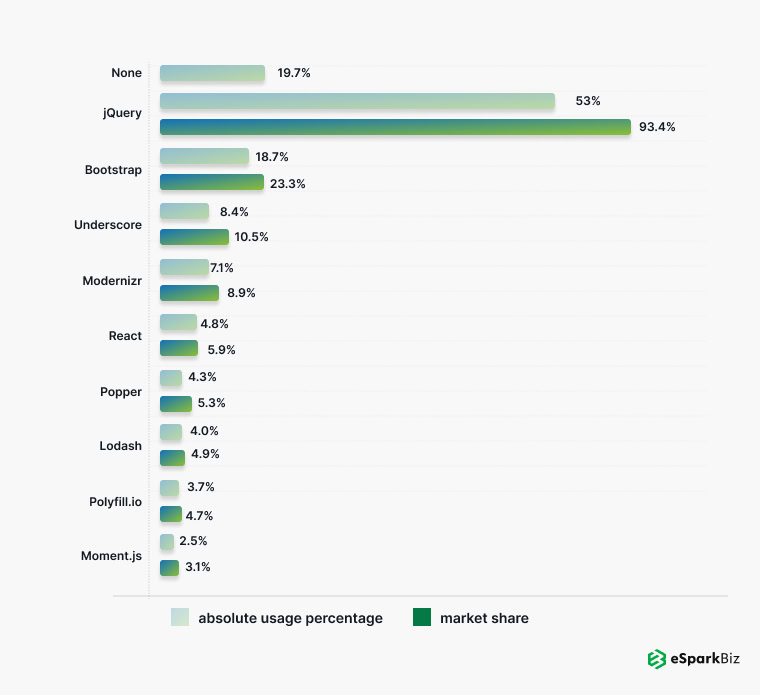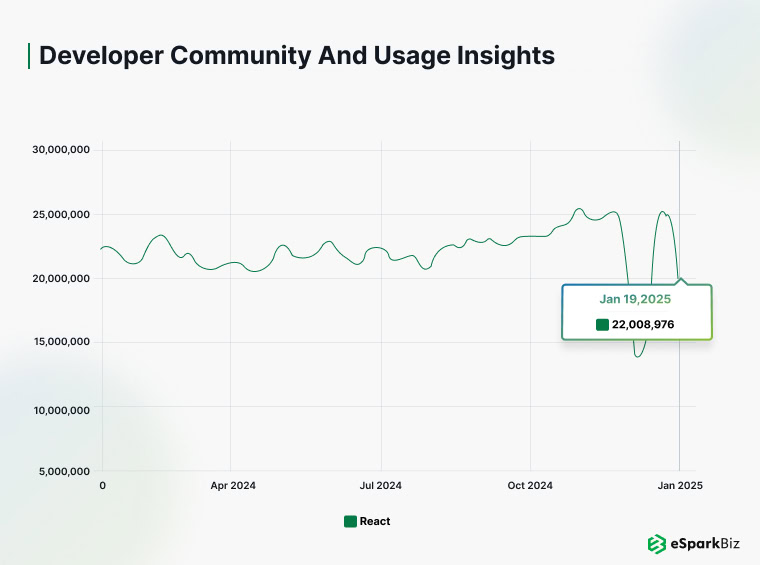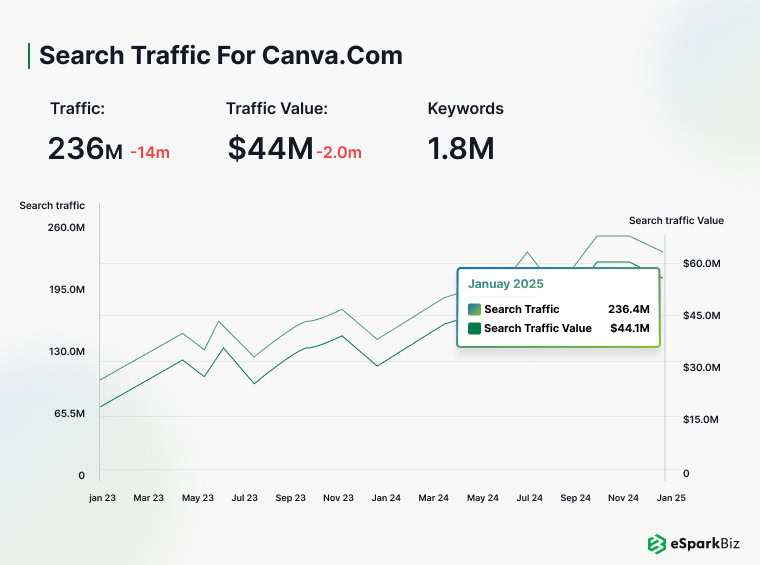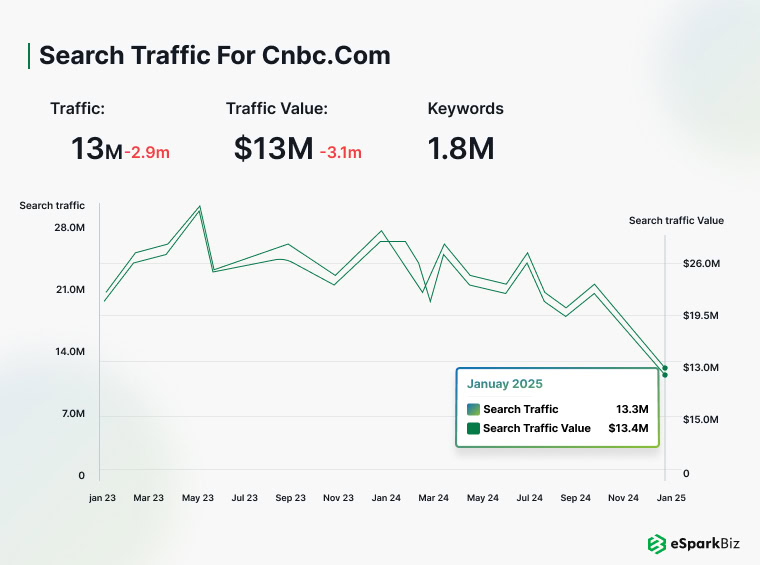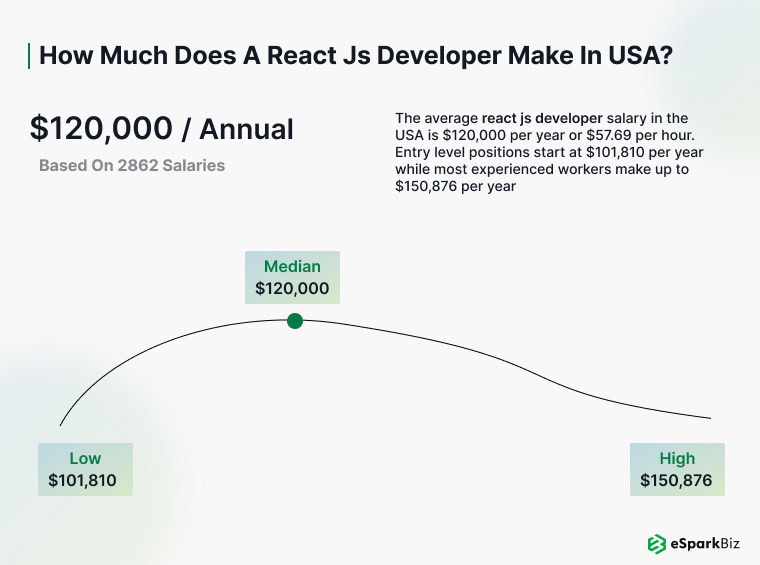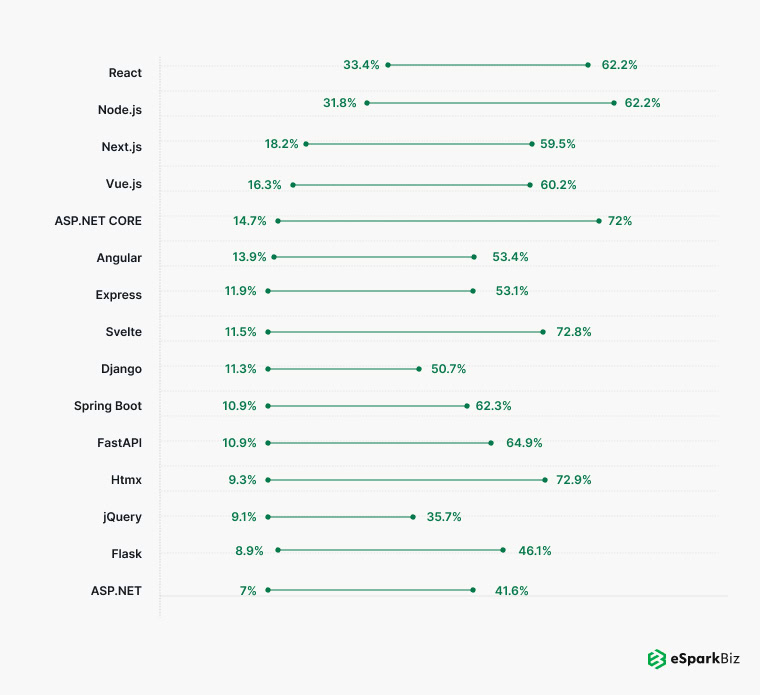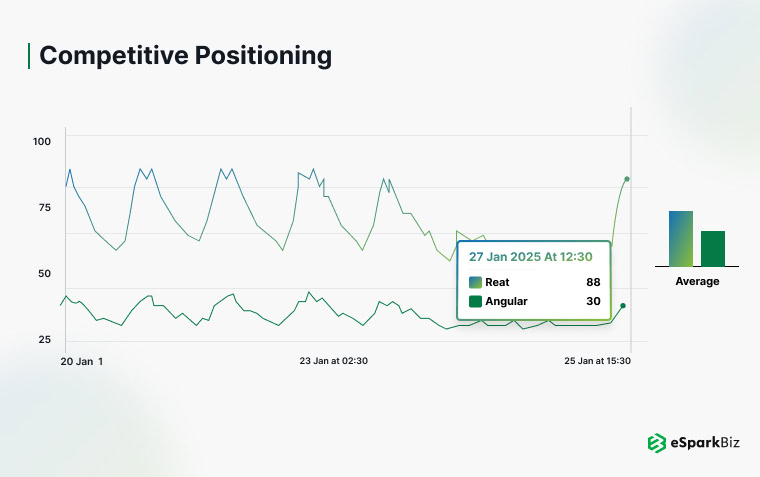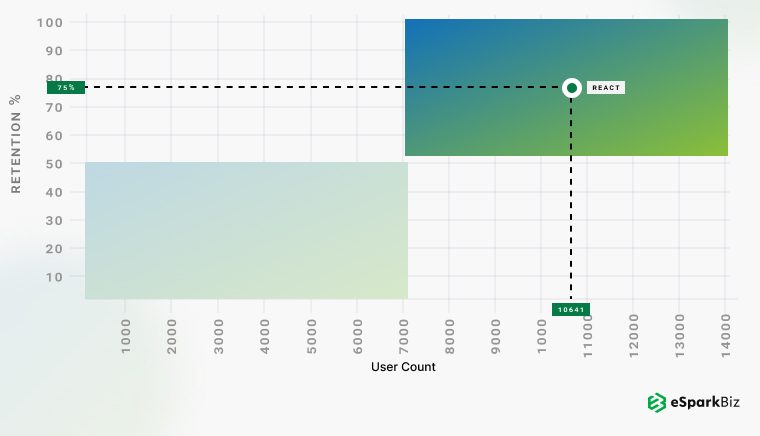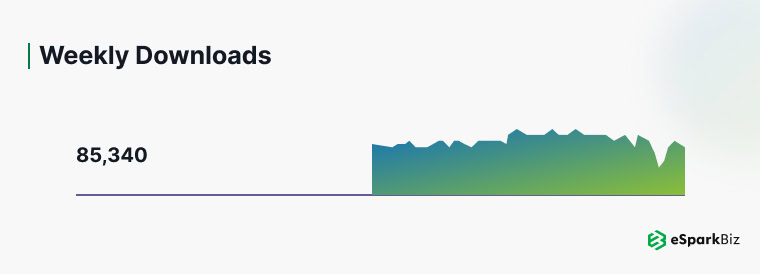Quick Summary :- React, the most popular JavaScript library for creating UI’s is still going strong in 2025. Here are 45+ React development statistics, developer habits, and performance by industry. React is one of the most popular choices among developers, still running millions of websites and mobile apps all over the world.
Facebook’s React is an open-source JavaScript library that is already one of the most popular and widely used libraries on the planet. Since its invention in 2013, React Development Trends has revolutionized the way developers write UIs with its component-based architecture that makes for much more reusable code.
This blog goes over 45+ React stats, showing the adoption of the library in the world and how it has been changing developer productivity, and most importantly, its influence on the future of technology. Whether you are a CTO, developer, or owner of a company, these React statistics will show you why React is still a preferred choice for today’s development. Here, have a look at the React usage statistics.
Understanding the Essential React Statistics for 2025
Here are some of the React statistics that you need to know:
Global React Usage Statistics
1. React runs on 4.8% of the websites out in the globe as one of the major JavaScript Libraries in 2025.
2. From stats, currently over 11 million websites throughout the world.
3. The top 10,000 highest-rated sites comprised around 6.2%. So, indeed indicates high-trafficked sites and making use of this application.
4. React has 5.9% of the global market share of the JavaScript library so it is still an absolute favorite.
5. Netflix, Airbnb, and Instagram are popular applications built using React, which is very common in enterprises.
Cross-Platform React Development Statistics
6. The demand for cross-platform development in the market of React Native is expected to increase at a 16.7% CAGR from 2023 to 2033.
7. Adopting React and React Native may save up to 40% of costs that involve development compared to traditional methods.
8. More than 40% of software developers claimed that they utilized React for web and mobile projects.
9. Professional Developers have a 9% preference for React native in cross-platform development solutions.
10. There are times when React will be adopted with the use of platforms such as Shopify Plus, where 7,244 websites make use of these two technologies.
Developer Community and Usage Insights
11. React has 207,000+ stars on GitHub, and it’s one of the most-followed repositories in the dev world.
12. React is downloaded more than 22 million times a week from NPM, so it’s really in high demand among developers.
13. According to the recent survey by StackOverflow Report 2024, there are around 41.6% of professional developers leverage ReactJS.
14. React is the second most popular framework with 36.6% of developers willing to learn coding.
15. React’s Component Architecture produces 60% faster development times than monolith architecture.
16. 43.21% of developers have positive experience using ReactJS which makes it the highly preferred frontend framework as compared to Angular & Vue with 30% & 18% respectively.
Performance and Speed Statistics
17. In the United States, 2,979,341 live websites are utilizing React.
18. Sites that are built with React render 15-20% faster than any JS library-used websites.
19. SSR in React delivers an increased crawl speed and 20% better ranking on the search engines.
20. React has been used by 73,029,602 total sites, including historical usage.
Also Read: React Performance Optimization Tips to Adhere for Enhanced UI Results
Industry Adoption and Use Cases
21. React Router registered over 9 million downloads in January 2025.
22. React is being used by more than 53,307 cart functionality websites from the world’s top brands such as Walmart and PayPal.
23. Canva – a popular design tool that uses React and has more than 236 million traffic visits.
24. React runs more than 46.4% of the world’s top 1000 websites.
25. CNBC, the major business news website, also uses React and has over 13 million monthly visits.
26. Business Insider Media uses React to offer an excellent reading experience and has monthly visits of 10 million.
Global Trends and Geographic Distribution
27. Of the 1 million websites with the highest traffic, 19% of the websites are React users, accounting for around 196,453 React-built websites.
28. Europe comes shortly after the US with large React adoption in the UK, Germany, and France with 2,211,390, 463,626, and 302,481 Live websites respectively.
29. The “.com” is the most popular domain among React users, used by 55.3% of the websites.
30. The second most popular domain among those that use React JS Technology as their JavaScript library is .org, which accounts for 6.1%, and the third most popular is .br, which accounts for 3.9%.
Career and Job Market
31. React developers in the United States are paid $120,000 annually.
32. Globally, it is estimated that there will be 500,000 to 600,000 React jobs in 2025, and it’s no wonder there is so much React expertise out there.
33. In terms of hourly rates, the salary of a Junior React developer falls between $30-$50/hour. Likewise, the Mid and Senior-level React Developers receive $46 and $64.
34. In India, the hourly rate of React developers ranges between $12–40 per hour, based on their experience.
35. React is one of the most admired Web Frameworks and Technologies with a score of 62.2%.
36. React job openings are expected to grow by 667,600 fresh job opportunities in the tenure 2020-2030, which shows that it’s gaining ground in the hiring arena.
Want to hire React Developers but have a Tight Budget?
Hire ReactJS Developers from eSparkBiz to have the Best React Talents at the affordable market price possessing expertise to effectively fulfill your React project needs.
Competitive Positioning
37. React is more flexible and easier to work with than Angular and therefore on average 88 developers prefer React while 30 prefer using Angular for their frontend development needs.
38. According to Google Trends, developers highly prefer React over Vue with a major preference difference of 9.13%.
39. React is a big winner at a 75% developer retention ratio along with a high user count, compared to Angular and Vue.
React’s Ecosystem, Tools, and Future Trends
40. 44% of the React applications are implemented with React Router and it provides the vital routing feature.
41. Redux is implemented in 59.6% of all React applications; it’s also the most common state manager for React.
42. React DevTools has weekly downloads of more than 85340 in January 2025 which shows how popular the debugger tools are.
43. React market size is expected to reach $28.6 billion by 2027, indicating substantial growth.
44. According to GitHub’s analysis of React repositories, 40% increase in the use of AI-assisted development tools.
45. Approximately 30% improvement can be achieved in React component reusability by leveraging AI capabilities
46. Around a 25% reduction in React Development bug fixes through AI-powered code analysis
47. 50% faster prototyping can be achieved by using ReactJS with AI-generated components
Top 10 Benefits of Using ReactJS
Now that you know about the trending React development statistics and overall React stats, let us see some of the benefits of React. React is a JavaScript library from Facebook, one of the most popular tools for UI development on web and mobile platforms.
React has been a widely popular coding framework with efficiency, adaptability, and a friendly interface since it was released in 2013.
Component-Based Architecture
The best part about React is that it’s component-driven so that developers can essentially reduce huge UI components into smaller reusable components. This React Component-based architecture aids in easier organization, management, and development.
Each React component is a standalone object with logic, hierarchy, and style. This means components can be reused throughout the app or even in different projects which drastically reduces the amount of code developers have to write.
Virtual DOM for Improved Performance
React supports Virtual DOM (Document Object Model), which is an unobtrusive copy of the original DOM. The way React updates the Virtual DOM first rather than refreshing the real DOM each time something changes. Then it checks the new Virtual DOM against a snapshot of the old one, reconciliation.
This way React re-renders only the components that have changed and not the whole page. This selective rendering speeds up applications, especially those with rich UI and frequent updates.
Declarative Syntax for Easier Debugging
Being a declarative programming language, React makes designing interactive UIs easier. Using declarative syntax, you can define what UI should look like based on where the application is — without having to worry about iterating over the UI.
This makes the process of building React apps more observable and debugging-friendly. For instance, when you update the state of a component, React automatically decides how to make the UI match. This minimizes errors from manual DOM updates and lets the developers focus more on their application needs
Strong Ecosystem and Third-Party Libraries
React stats suggest that React has a vast ecosystem and offers a wide variety of third-party libraries, tools, and extensions that developers can leverage to accomplish common tasks. From State Management Tools like Context APIs and Redux with ReactJS to routing tools like React Router, there’s a library for every use case.
The React Developer Tools browser extension is another great piece of the ecosystem that allows you to inspect and debug your React applications from the browser.
SEO Friendly with Server-Side Rendering (SSR)
Search engine optimization (SEO) is one of the most important parts of any website or web application. Traditional client-side rendered (CSR) JavaScript architectures pose SEO issues since search engines can’t index dynamic content, SEO for React fixes that with server-side rendering (SSR).
SSR can be implemented using React with Next.js library, which makes it super fast to load your first page and optimize for SEO. This is very helpful for the companies who want to get organic traffic from the search engines.
Strong Community Support
The other biggest plus of React is its community. React is one of the most widely used open-source libraries, and the community of developers, contributors, and users keeps evolving the library to develop new tools and resources.
The powerful React community means that there’s always something for developers- tutorials, forums, documentation, plugins, and more.
Cross-Platform Development with React Native
React’s main strength is that you can use it for cross-platform mobile app development. Using React with React Native, you can write code for iOS and Android from the same code base. This saves time and money since companies can extend their business reach without developing different native apps on different platforms.
With React Native, developers can build their websites using the same React principles and libraries that they are used to in web development. React Native’s native modules let developers also get platform-specific APIs which help them build performant, feature-rich mobile apps.
Also Read: Cross-Platform Development in ReactJS: A Trusted Approach for Modern Apps
Easy Learning Curve
React is not too hard to learn, compared to other vital front-end frameworks such as Angular. Because React is a system built with small, reusable pieces it’s easy to use and understand for JS developers.
React is very simple and has good documentation as well as a lot of tutorials and resources available, it’s an excellent option for beginner developers when starting with front-end development.
Powered by Facebook and Daily Updates
React is sponsored by Facebook which means not only is the library going to be maintained and supported but also it is always in development.
Facebook uses React extensively on its products like the Facebook and Instagram pages which make sure that React is still a frontrunner in today’s web development.
Therefore, every reputed ReactJS Development Company highly prefer the technology for achieving scalable, interactive and dynamic solutions.
Flexible and Scalable Applications
The architecture of React is very adaptable, and developers can create scalable applications with it. Because it’s a one-way data path, changes in the data are predictable and controllable (a critical factor for large-scale, high-volume projects).
Programmers can use React with any backend technology, library or other front-end technology. That’s how it is appropriate for everything from static web pages to dynamic web apps and enterprise-grade applications.
Conclusion
So, that’s all about React usage statistics. There is no denying that React is in an ever-increasing growth rate, establishing itself as the go-to framework for creating responsive and scalable React applications in 2025. Because of its performance, versatility, and large developer community, React is a favorite for developers from all industries. When companies keep adopting React, the web, and mobile app development future will be influenced by it.
Frequently Asked Questions
What is React used for?
React is one of the most widely used prominent JavaScript Frameworks to create user interfaces, specifically SPAs. It allows developers to develop reusable components that reload the UI whenever it’s time to update the entire page. React is an open-source web and mobile application development framework with performance and scalability.
How Popular is React in 2025?
React statistics show that React is still one of the most used JavaScript libraries in 2025 with more than 11 million websites running on it worldwide. It is the holder of a 45.8% market share in the JavaScript library market. There are so many large platforms like Facebook, Instagram, and Netflix that use React, and this means it is everywhere, and keeps being around for a while.
Is React better than Angular or Vue?
React has become the choice over Angular and Vue for simplicity, modularity, and ecosystem. React is a lightweight library but not as powerful as Angular. It’s more interoperable with other libraries, and easier to learn than Angular or Vue.
How much do React developers make?
React developers in the United States get a $120,000 salary per year on average. There is a high need for React developers as it is becoming very popular in web and mobile app development. The rates may be higher as well if the freelancer or contractors are experienced and knowledgeable.
Can React be used for mobile development?
Well, yes, React can be integrated with mobile applications through React Native, which is an open-source toolkit for creating cross-platform iOS and Android mobile apps based on the same React. This helps you reuse code, develop quickly, and keep maintenance low, so it’s very efficient for developing mobile applications.
